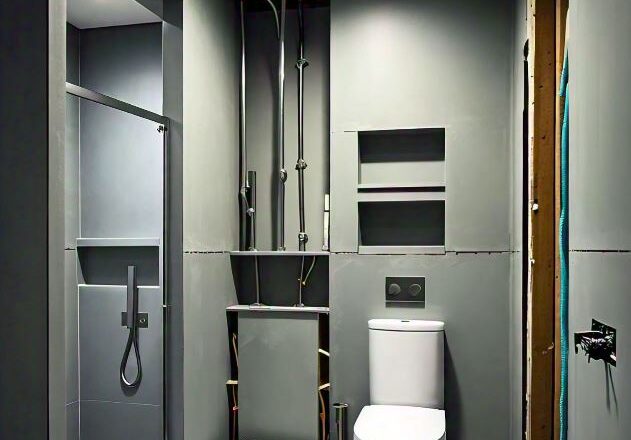Introduction
Rough-in plumbing is a crucial initial phase in building or remodeling projects. It involves setting up the basic framework of the plumbing system before the installation of final fixtures and finishes.
Proper rough-in plumbing ensures that the water supply and drainage systems function efficiently and that the final fixture placement aligns perfectly with the planned design. This article explores the importance of rough-in plumbing and its impact on the final placement of fixtures.
What is Rough-In Plumbing?
Rough-in plumbing involves installing the pipes and connections necessary for water supply, drainage, and venting before the walls, floors, and ceilings are finished. It sets the stage for the final plumbing phase, which includes installing sinks, toilets, faucets, and other fixtures. This stage includes:
- Positioning and installing drain lines and vents.
- Setting up water supply lines.
- Mapping out where fixtures like sinks, toilets, and bathtubs will be placed.
Importance of Proper Rough-In Plumbing
1. Compliance with Building Codes
Proper rough-in plumbing ensures compliance with local building codes and regulations. These codes are designed to ensure safety, efficiency, and the correct functioning of plumbing systems. Adhering to these standards during the rough-in phase prevents potential legal and functional issues later on .
2. Accurate Fixture Placement
The accurate layout of rough-in plumbing is essential for the precise placement of final fixtures. Misaligned pipes or incorrect measurements can lead to fixtures being placed incorrectly, causing functionality issues and aesthetic problems. For example, a mispositioned toilet flange can result in the toilet not fitting correctly or being too close to a wall, which is both inconvenient and unsightly .
3. Avoiding Costly Mistakes
Mistakes made during the rough-in plumbing phase can be costly and difficult to fix once walls and floors are finished. Proper planning and precise execution during rough-in help avoid these issues. For instance, if a drain pipe is installed at an incorrect slope, it can lead to drainage problems that might require tearing out walls to correct .
Key Elements of Rough-In Plumbing
1. Water Supply Lines
Water supply lines must be accurately positioned to ensure that fixtures receive an adequate supply of water. Properly installed supply lines prevent leaks and ensure consistent water pressure. The placement of these lines must consider the future location of sinks, showers, and toilets .
2. Drainage Pipes
Drainage pipes must be installed with the correct slope to facilitate the efficient flow of wastewater. Incorrectly sloped pipes can cause blockages and slow drainage. Drainage systems must also be properly vented to prevent sewer gases from entering the building and to maintain proper pressure within the plumbing system .
3. Vent Pipes
Vent pipes are crucial for allowing sewer gases to escape and for maintaining atmospheric pressure within the drainage system. Properly placed vent pipes ensure that fixtures drain efficiently and prevent the unpleasant odors associated with sewer gas leaks .
The Rough-In Process
1. Planning and Layout
Before starting rough-in plumbing, detailed planning is essential. This involves creating a layout that shows where all pipes and fixtures will be placed. This plan must take into account the architectural design of the building and ensure compliance with local plumbing codes .
2. Installation of Pipes
Once the layout is finalized, the installation of water supply lines, drainage pipes, and vent pipes begins. This includes boring holes in wall studs and floor joists to run pipes through. Each pipe must be measured and cut to the correct length, and all connections must be securely fastened to prevent leaks .
3. Testing and Inspection
After the rough-in plumbing is installed, it must be tested and inspected to ensure everything is functioning correctly and complies with building codes. Pressure testing is often used to check for leaks in the water supply system, while smoke or air tests can be used to check for leaks in the drainage and vent systems .
Impact on Final Fixture Placement
Proper rough-in plumbing directly influences the placement and functionality of final fixtures. Accurate rough-in ensures that fixtures are positioned correctly, which is crucial for both functionality and aesthetics. For instance:
- Sinks and Vanities: Properly positioned supply and drain lines ensure that sinks fit perfectly into countertops and that vanity cabinets do not obstruct plumbing.
- Toilets: The flange must be positioned at the correct distance from the wall to ensure that the toilet fits properly and is comfortable to use.
- Showers and Bathtubs: Accurate placement of water supply and drain lines ensures that showers and bathtubs function efficiently and fit within the designed space.
Conclusion
Proper rough-in plumbing is essential for the successful placement and functionality of final plumbing fixtures. By adhering to building codes, ensuring accurate measurements, and conducting thorough testing, the rough-in phase sets a solid foundation for the final plumbing installation. This attention to detail helps prevent costly mistakes, ensures efficient water flow, and guarantees that fixtures are placed exactly as planned, contributing to the overall success of the construction or renovation project.

